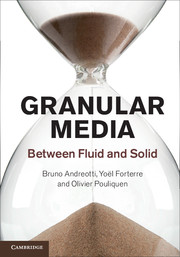8 - Erosion and sediment transport
Published online by Cambridge University Press: 05 June 2013
Summary
In this chapter, we study erosion and sediment transport from the point of view of the physics of granular media. Situations involving erosion, transport and deposition of particles subjected to fluid flow cover a wide range of applications, from the transport of grains in a pipe to the evolution of landscape on geological scales. We focus in this chapter on the study of erosion and transport of natural sediments under the influence of a water flow (streaming, fluvial erosion, tides, waves and glaciers) or of the wind (dunes, sand invasion, desertification). Besides, we wish to describe sediment transport in the perspective of understanding the geological phenomena that will be discussed in the next chapter. The goal is to propose a description of these phenomena, to model them through basic equations and to explain the dynamical mechanisms at the scale of grains. To do this, we will use the concepts introduced throughout this book.
We begin by briefly outlining the characteristics of the different modes of transport and the most important concepts which allow one to characterize erosion and sediment transport (Section 8.1). We then discuss the nature of the threshold above which a flow may entrain grains into motion (Section 8.2), before presenting the formalism used to describe erosion and transport starting from conservation laws (Section 8.3). Once we have introduced the concepts of saturated transport and saturation transient, we apply them to the different modes of transport: bed load (Section 8.4), aeolian transport (saltation and reptation) (Section 8.5) and turbulent suspension (Section 8.6).
- Type
- Chapter
- Information
- Granular MediaBetween Fluid and Solid, pp. 311 - 362Publisher: Cambridge University PressPrint publication year: 2013

